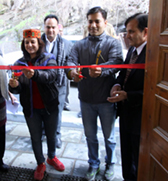|
The International Women’s Day was celebrated in the Himalayan Roerich House in Naggar with great enthusiasm. The tradition of celebrating this comparatively new for India and virtually unknown in the Kullu valley holiday in the International Roerich Memorial Trust was initiated last year by the Russian and Indian Curators of the IRMT.
Within the framework of this celebration the exhibition of paintings by a Mandi artist Sapna Sharma opened in the IRMT. It was inaugurated in the presence of SDM Kullu Rohit Rathore, who was the Guest of Honour at the function.
Mrs. Sharma exhibited 25 works, of mostly religious contents and depicting Hindu deities. They included the pictures of Durga seated on a lion, valiant Hanuman incinerating Lanka, the city of demons, the goddess of happiness and prosperity Lakshmi showering coins, Radha and Krishna exuding tenderness, unforgettable Ganesha, little Krishna pilfering butter etc. Mrs. Sharma said that she never studied art, although she started drawing in childhood. Before painting a picture she visualizes the deity she is going to paint. Thus, painting has become a meditation practice for her.
Addressing the guests Mr. Ramesh Chander, Indian Curator, IRMT remarked that in the past women were prevented from expressing themselves through art. Therefore, awakening and encouraging creativity of women is one of the IRMT’s objectives. He also drew guests’ attention to the religious aspect of Mrs. Sharma’s art. Her painting expresses dharma, the sacred universal law, and in this it is akin to the paintings of the ancient cave temples of Ajanta and Bagh, in the depths of which the religious art of India was developed. He added that in India where art has always been religious men of art have been similar to wise saints – manishis. Congratulating the assembled women with the Women’s Day he mentioned that only that society, which respects women, is capable of developing.
Mrs. Larisa Surgina, Russian Curator, IRMT underscored the global dimension of the holiday. She reminded the guests about the significance of the feminine in the worldview of the Roerichs, and remarked that the unity and harmonious development of the masculine and the feminine together form one of the fundamental laws of the universe.
SDM Kullu Rohit Rathore praised Mrs. Sharma for a wonderful and balanced representation of the Hindu deities. He said that the opening of this exhibition was a remarkable event not only for Mrs. Sharma herself but for the entire population of Kullu valley. Congratulating the guests with the Women’s Day Mr. Rathore quoted the famous the famous Sanskrit aphorism on the significance of woman: yatra naryas tu pujyante tatra ramyante devatah (Gods rejoice where women are honoured).
Cultural programme opened with the prayer to the goddess of art and learning Sarasvati. It was followed by a song-and-dance item “Suno meri awaz!/Hear my voice” performed by two female students of the Helena Roerich Academy of Arts for Children. The item was dedicated to the highly relevant for India topic of women empowerment. Then the students and teachers of the Academy performed a college of popular songs from old Indian films including the song from Raj Kapoor’s film Awara well-known in Russia.
That was followed by the traditional kathak recital and the raga Kafi associated with Holi, the festival of spring and colours, which was celebrated in Naggar on March 5 with great enthusiasm.
Wishing to add some Russian flavour to the cultural programme several female students of the Academy sang a Russian song from the famous Soviet film for children “Guest from the Future.”
The elder women from Naggar including several employees of the IRMT added unforgettable local flavor to the festivities, having performed several folk songs in the Kullu dialect.
The programme closed with the local dance natee, which was gladly joined by all those present. The atmosphere was gay and festive despite the dark clouds hanging over the valley and discharging cold rain, these two inalienable attributes of Naggar winter, which would not surrender to the spring even though it is already March.
| 
